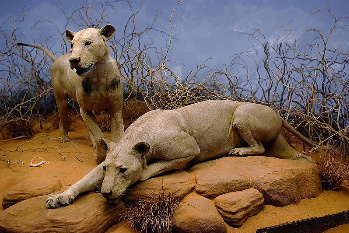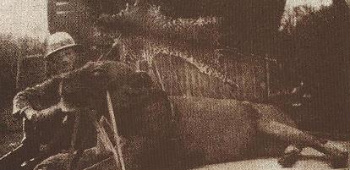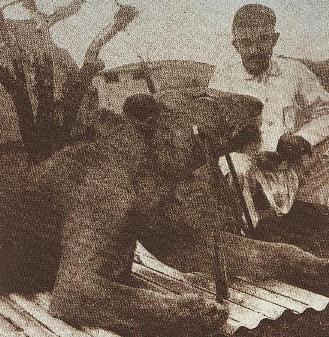A recent study in the Proceedings of the National Academy of Sciences has shown that the two man-killing lions of Tsavo very likely did not kill and eat as many people as claimed. Looking at hair and bone samples from the pair of male lions, now resting in the Chicago Field Museum, researchers were able to determine that the Tsavo lions likely killed and ate approximately 35 people, not 135 as claimed by Lieutenant Colonel John H. Patterson. Patterson became famous for shooting and killing the lions in December 1898. For nine months the two lions terrorized a railroad camp in Kenya.
 The stuffed Tsavo lions at the Chicago Field Museum. Photo by: Jeffrey Jung. |
Despite Patterson’s claim that the lions ate 135 people, the Ugandan Railway Company undertaking the construction of the railroad said that the lions killed and ate only 28 people. Until now no one knew for certain.
“This has been a historical puzzle for years, and the discrepancy is now finally being addressed,” said Nathaniel J. Dominy, an associate professor of anthropology at University of California—Santa Curz. “We can imagine that the railroad company might have had reasons to want to minimize the number of victims, and Patterson might have had reasons to inflate the number. So who do you trust? We’re removing all those factors and getting down to data.”
To discover just how many people the Tsavo lions killed and ate researchers analyzed samples of hair and bone from each of the lions. Researchers then compared their findings to isotopic signatures of the lions’ prey: African ungulates and humans. They found that it was likely that one of the lions ate 11 people, while the other ate 24.
 One of the Tsavo lions after being killed. |
The results displayed a difference in dietary preference for the lions. One of the lions largely fed on the normal diet, like antelope. While the other fed more widely on humans. Yet, despite their different diet, the lions by all accounts worked in concert. Researchers say that they suspect that the Tsavo lions worked cooperatively to bring down their prey—both human and antelope—but during eating one lion consumed human, while the other stuck to antelope.
“The idea that the two lions were going in as a team yet exhibiting these dietary preferences has never been seen before or since,” said Dominy.
Lions are cooperative hunters when it comes to big game, such as African buffalo, but typically man-eating lions work alone, as humans are small enough for one cat to kill.
The researchers believe that a unique situation brought about the behavior: drought and disease had led to a decline in the lions’ normal prey, and it is known that one of the lions suffered from a jaw injury and dental problems making it difficult to hunt in a conventional manner.
 One of the Tsavo lions after being killed. |
“These findings underscore the complexity of what lions are capable of doing, and the complex interplay of costs and benefits that determine the size of their coalitions,” he said.
While results show just how many people each lion ate, the number of people killed by the pair remains a mystery.
“The railroad company attributed the deaths of 28 Indian nationals to the lions, and Patterson may have reasonably assumed scores of Africans were also killed,” said Dominy. “But based on our statistical analysis, there’s an outside chance they ate as many as 75 people. Our evidence attests only to the number of people eaten, not the number of people killed.”
Related articles
Lion population in Kenya could disappear in 10 to 20 years
(08/20/2009) The Kenyan Wildlife Service recently announced that massive declines in lion population may lead to their disappearence from the region within less than 2 decades. Kenya currently has an estimated 2000 lions, but is losing the large cats at a rate of around 100 each year.
Lion die-offs in Africa linked to global warming
(06/26/2008) Scientists have linked climate shifts in East Africa to die-offs in lion populations in 1994 and 2001. The research is published in the open-access journal PLoS ONE.
Africa’s lions are disappearing

(03/25/2008) The lion is Africa’s best known carnivore. Once widely abundant across the continent, recent surveys show that lion populations have plunged from over 100,000 individuals to around 23,000 over the past century. The reason? Lions are poisoned, shot, and speared by locals who see them as a threat to livestock. While lion populations in protected areas remain relatively healthy, conservationists say that without urgent measures, lions may disappear completely from unprotected areas. The Kilimanjaro Lion conservation Project is working to avoid this fate by developing practical measures to encourage coexistence between people, livestock and predators. Key to the effort is reducing livestock losses to lions. Leela Hazzah, a field researcher with the project, says the “Lion Guardians” program at Mbirikani Ranch in Kenya has proved remarkably successful: not a single lion has been killed since its inception in November 2006. The program employs Maasai warriors to monitor lions and help local communities prevent attacks on livestock.